Lava lamps have captivated people with their mesmerizing, flowing colors for decades. Originally popularized in the 1960s and 1970s, these unique decor pieces have retained their charm and continue to be a favorite DIY project for enthusiasts of all ages.
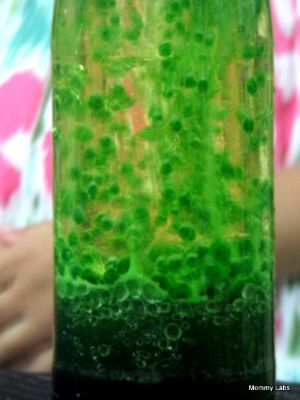
Understanding how a lava lamp works is the first step towards creating your own. Combining simple ingredients like oil, water, coloring, and heat can bring the magic of lava lamps into your home. This guide will provide step-by-step instructions, safety tips, troubleshooting advice, and creative ideas to help you make your lava lamp. Get ready to unleash your creativity and enjoy the captivating beauty of your homemade lava lamp creation.
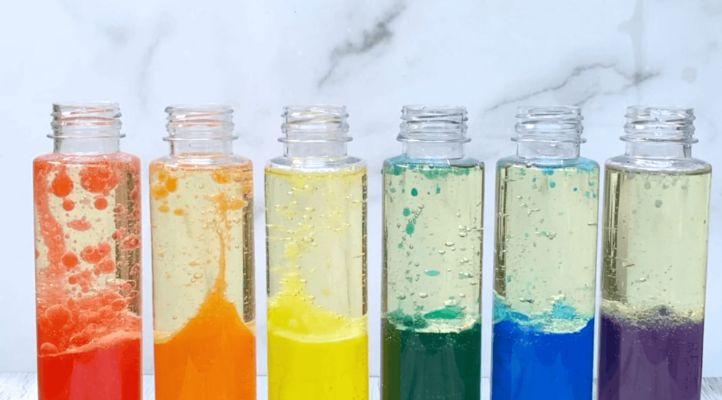
Materials and Tools Needed for Making a Homemade Lava Lamp
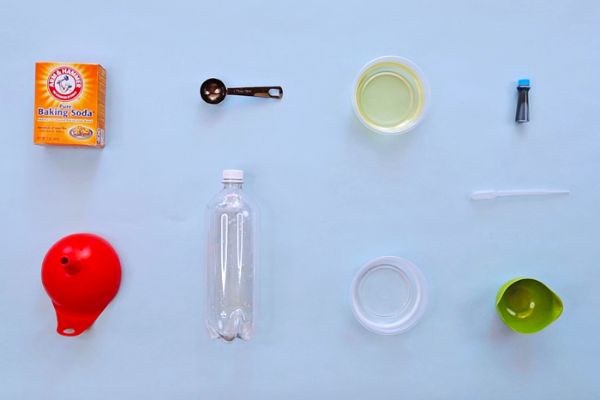
To make a lava lamp, you will need the following materials and tools:
- Glass container: Select a clear glass container with a wide opening to create a visually appealing lava lamp display. A glass vase or a large glass bottle works well.
- Oil: You will need a clear, lightweight oil such as mineral or liquid paraffin. This oil will serve as the base for the lava lamp and enable the floating effect.
- Water: Distilled water is recommended to prevent mineral deposits and ensure clarity in your lava lamp.
- Coloring agent: Choose liquid or gel-based coloring agents specifically for oil-based solutions. These can be found at craft stores or online. Opt for vibrant colors to create striking visual effects.
- Glitter (optional): Adding glitter can enhance the visual appeal of your lava lamp by creating a sparkling effect. Choose fine or medium-sized glitter in colors that complement your chosen coloring agent.
- Heat source: A small light bulb or LED light is typically used to provide heat and initiate the lava lamp’s motion. Ensure the heat source is compatible with the lamp’s size and wattage requirements.
- Socket and cord: If you opt for a light bulb as the heat source, you will need a socket and cord to connect it to a power source. Ensure the cord length is appropriate for your setup.
- Sealant (optional): If your glass container doesn’t come with a fitted stopper or cap, you may need a sealant like silicone glue or a cork to seal the container once the lamp is assembled securely.
- Protective gloves: Since you’ll be working with various materials and possibly hot objects, wearing protective gloves is recommended to prevent burns or skin irritation.
- Funnel: A funnel will come in handy for pouring the liquids into the glass container, ensuring a clean and spill-free process.
Having these materials and tools ready will make the lava lamp-making process smoother and more enjoyable.
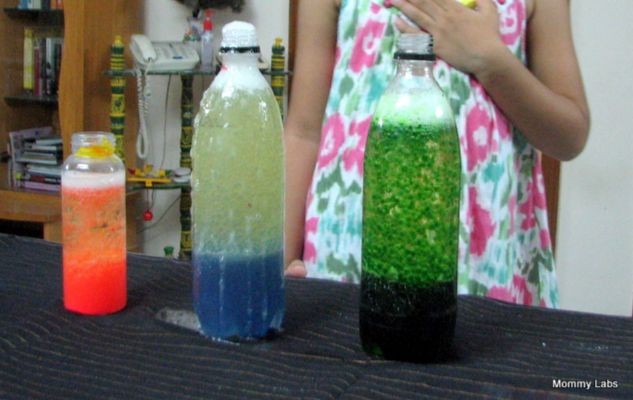
DIY Lava Lamp – Step-by-Step Guide for Creating Your Own
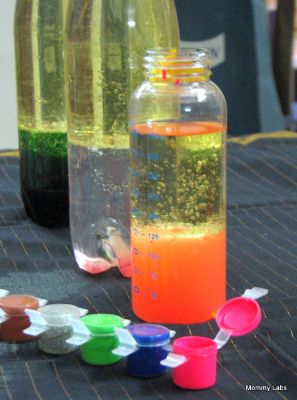
Preparing the Glass Container
- Ensure the glass container is clean and free of any dust or residue.
- If desired, decorate the outside of the container using paint, stickers, or other decorative elements.
- Set the container on a stable surface where it will remain undisturbed.
Mixing the Liquid Solution
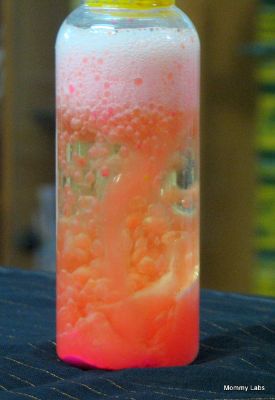
- Fill the glass container about three-quarters full with the chosen clear oil (mineral oil or liquid paraffin).
- In a separate container, mix distilled water with a few drops of your chosen coloring agent. Stir well until the color is evenly distributed.
- Slowly pour the colored water into the glass container, leaving some space at the top for the bubbling effect.
Adding Coloring and Glitter
- Add additional drops of coloring agent if you desire a more vibrant color. Stir gently to mix.
- If using glitter, sprinkle a small amount into the container. Be cautious not to add too much, as it may interfere with the flow of the lava.
Adding the Oil and Water
- Add more clear oil to the container, filling it almost to the brim. Leave a small gap at the top to prevent overflow.
- The oil and water will form separate layers in the container.
Creating the Lava Effect
- Insert the chosen heat source into the container. Ensure it is secure and positioned in the center.
- Plug in the heat source or turn it on if it’s battery-powered. The heat will warm the liquid and initiate the movement.
- As the heat source warms the bottom layer of the liquid, the colored water will rise and fall, resembling flowing lava.
Sealing the Lava Lamp
- If your glass container has a fitted stopper or cap, secure it tightly to prevent leaks or spills.
- If not, carefully apply a sealant, such as silicone glue or a cork, to seal the opening of the container. Allow it to dry completely before using the lava lamp.
Once you have followed these steps, you can sit back and enjoy the mesmerizing display of your homemade lava lamp. Remember to exercise caution when handling the heat source and avoid shaking or tilting the lamp while it is in operation.
Important Considerations for Making a Lava Lamp
When working on your lava lamp project, it is important to prioritize safety. Here are some key safety considerations to keep in mind:
| Safety Measures | Instructions |
| 1. Wear protective gloves | Put on protective gloves before handling any materials. |
| 2. Consider safety goggles | If there is a risk of splashing or spilling liquids, consider wearing safety goggles. |
| 3. Handle heat source with caution | When handling the heat source (light bulb or LED light), exercise caution to prevent burns. |
| 4. Turn off and unplug heat source when not in use | Ensure that the heat source is turned off and unplugged when not in operation. |
| 5. Avoid touching the heat source when hot | Allow the heat source to cool down before touching it to prevent burns. |
| 6. Follow manufacturer’s instructions for handling chemicals | Read and follow the instructions provided by the manufacturer for handling coloring agents and other chemicals. |
| 7. Avoid ingestion or direct contact with chemicals | Do not consume or come into direct contact with the coloring agents or any other chemicals used in the process. |
| 8. Handle glass container carefully to prevent breakage | Be cautious when handling the glass container to avoid dropping or hitting it against hard surfaces. |
| 9. Avoid dropping or hitting the glass container against hard surfaces | Take care not to drop or strike the glass container to prevent it from breaking. |
| 10. Ensure electrical cord is in good condition | Check that the electrical cord used for the heat source is in good condition, free from damage or fraying. |
| 11. Place electrical cord away from water and tripping hazards | Position the electrical cord in a location where it will not come into contact with water or pose a tripping hazard. |
| 12. Provide adequate supervision for children | If children are involved in the project, ensure they are supervised by an adult throughout the process. |
| 13. Work in a well-ventilated area to prevent inhalation of fumes | Set up your workspace in a well-ventilated area to avoid inhaling any fumes that may be released during the process. |
| 14. Keep workspace clean and organized | Maintain a clean and organized workspace to prevent accidents or spills. |
| 15. Promptly clean up spills | If any spills occur, clean them up promptly to prevent slips or falls. |
Troubleshooting Tips – Fixing Common Issues with Your Lava Lamp
While making a lava lamp, you may encounter common issues affecting its performance or visual appeal. Here are explanations and tips for troubleshooting these issues:
Cloudy or Separated Liquids
- Issue: If your liquids appear cloudy, separate into distinct layers instead of flowing smoothly.
- Troubleshooting: Use distilled water instead of tap water, as minerals can cause cloudiness. Ensure the oil and water are thoroughly mixed before adding them to the container. If the liquids are still separate, add a small amount of dish soap to help emulsify and keep the liquids mixed.
Lava Not Flowing
- Issue: If the colored lava blobs are not forming or moving as desired.
- Troubleshooting: Check the heat source to ensure it generates enough heat. Ensure the heat source is positioned properly in the center of the container. Adjust the amount of oil and water in the container to achieve the desired flow. If needed, gently swirl the container to encourage movement.
Insufficient Lava Effect
- Issue: If the lava effect is too small or not visually striking.
- Troubleshooting: Adjust the ratio of oil to water in the container. Adding more water may increase the size and visibility of the lava blobs. Experiment with different coloring agents and glitter to create more dynamic and eye-catching effects.
Overheating or Leaking
- Issue: If the heat source becomes too hot, causing the glass container to heat up excessively, or if there are leaks in the container.
- Troubleshooting: Use the appropriate wattage light bulb or adjust the heat source to a lower setting if possible. Ensure the container is properly sealed to prevent leaks. Monitor the lava lamp closely during operation to avoid overheating.
Unclear or Diminished Colors
- Issue: If the colors in the lava lamp appear dull or less vibrant than desired.
- Troubleshooting: Adjust the amount of coloring agent used, adding more if needed. Ensure the coloring agent is well-mixed with the water before adding it to the oil. Consider using more vibrant or concentrated coloring agents for stronger colors.
Excessive Bubbles
- Issue: If there are too many bubbles in the liquid, hindering the lava effect.
- Troubleshooting: Reduce the water used in the mixture, as excessive water can cause increased bubbling. Avoid shaking or disturbing the lava lamp while it is in operation to minimize the formation of bubbles.
Lava Sticking to the Glass
- Issue: If the lava blobs stick to the sides of the glass container and do not freely flow.
- Troubleshooting: Ensure the container is clean and free from any residue that may cause the lava to stick. Adjust the ratio of oil to water to achieve the desired viscosity. Adding a small amount of dish soap can also help reduce sticking.
Floating Debris
- Issue: If visible particles or debris are floating in the liquid, affecting the visual appeal.
- Troubleshooting: Strain the oil and water mixture before adding it to the glass container to remove impurities. Use a fine mesh strainer or cheesecloth to filter out debris. If necessary, let the mixture settle before pouring it into the container.
Uneven Heating
- Issue: If the heat source is not evenly distributing heat, causing erratic movement or flow.
- Troubleshooting: Ensure that the heat source is positioned at the center of the container. If using a light bulb, ensure it is fully inserted and secure in its socket. Consider using a heat-resistant base or platform to distribute heat more evenly across the bottom of the container.
Long Warm-up Time
- Issue: If it takes an extended period for the lava lamp to warm up and start flowing.
- Troubleshooting: Check if the heat source is the appropriate wattage for the container size. Consider using a higher-wattage bulb or heat source for faster warming. Preheat the lamp by leaving it on for a few minutes before observing the flow.
DIY Homemade Lava Lamp with Alka-Seltzer
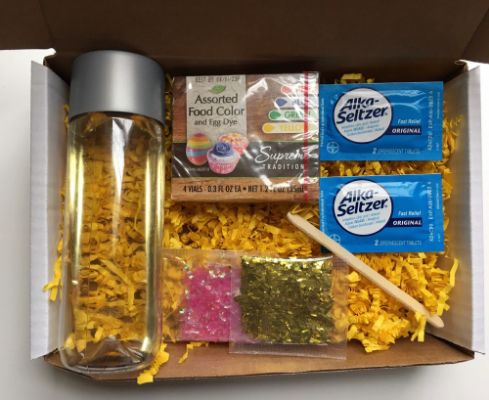
Making a lava lamp with Alka-Seltzer tablets is a fun and easy project. Alka-Seltzer tablets react with water to produce effervescence, creating bubbles that resemble the lava lamp effect. Here’s a step-by-step guide on how to make a DIY lava lamp using Alka-Seltzer:
Materials and Tools Required
- Clear plastic bottle or glass container
- Water
- Vegetable oil or mineral oil
- Food coloring
- Alka-Seltzer tablets
- Funnel (optional)
- Stirring utensil
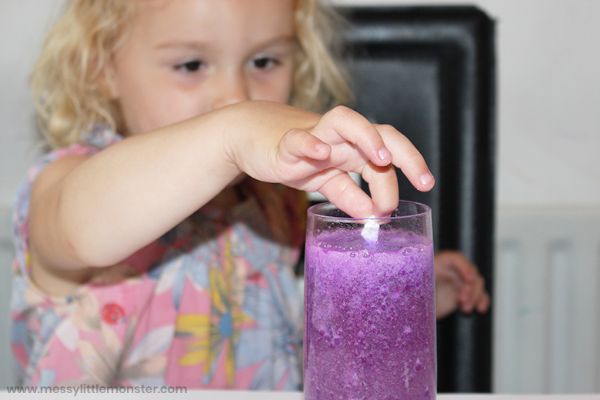
Step-by-Step Instructions To Make Lava Lamp with Alka-Seltze
Prepare the Container
- Start by cleaning the plastic bottle or glass container to ensure it is free from residue or impurities.
- If using a plastic bottle, remove any labels or stickers from the surface.
Fill the Container
- Fill the container about three-quarters full with vegetable oil or mineral oil.
- Leave some space at the top to allow for the bubbling effect.
Add Water and Coloring
- Mix water with a few drops of food coloring in a separate container.
- Stir well to distribute the color evenly.
- Use a funnel (if available) to carefully pour the colored water into the container with oil, filling it almost to the brim.
Break Alka-Seltzer Tablets
- Break an Alka-Seltzer tablet into several small pieces.
- You can use one or more tablets depending on the desired intensity of the lava effect.
Start the Reaction
- Drop a small piece of the Alka-Seltzer tablet into the container.
- Observe as the tablet reacts with water, producing carbon dioxide bubbles that rise through the oil, creating the lava lamp effect.
Repeat as Desired
- Once the enthusiasm subsides, add more Alka-Seltzer tablet pieces to continue the reaction and prolong the lava lamp effect.
- Add additional pieces as needed to maintain the desired activity level in the lamp.
| Remember to exercise caution when handling Alka-Seltzer tablets and avoid ingesting them. It’s also important to clean and dispose of the used tablets properly. |
Homemade Lava Lamp Experiments
Oil and Water Lava Lamp
Materials
Clear glass container, vegetable oil, water, food coloring, Alka-Seltzer tablet.
Procedure
Fill the glass container three-quarters full with vegetable oil. Mix water with a few drops of food coloring in a separate container. Carefully pour the colored water into the glass container, almost filling it. Break an Alka-Seltzer tablet into small pieces and drop one piece into the container. Observe as the tablet reacts with water, producing carbon dioxide bubbles that rise through the oil, creating a stunning lava lamp effect.
Density Lava Lamp
Materials
Clear glass container, water, cooking oil, and food coloring.
Procedure
Fill the glass container one-third full with water. Slowly pour cooking oil on the water until it reaches the desired level. Add a few drops of food coloring to the mixture. Observe as the liquids separate into distinct layers based on their densities, creating a visually appealing lava lamp effect.
Glitter Lava Lamp
Materials
Clear glass container, water, vegetable oil, food coloring, glitter, and Alka-Seltzer tablet.
Procedure
Fill the glass container halfway with water. Pour vegetable oil on top, leaving some space at the top. Add a few drops of food coloring and sprinkle in glitter. Drop an Alka-Seltzer tablet into the mixture, and observe as the tablet reacts, creating a bubbling effect with glitter suspended in the liquids, resembling a sparkling lava lamp.
Glow-in-the-Dark Lava Lamp
Materials
Clear glass container, tonic water (glow-in-the-dark), vegetable oil, and food coloring.
Procedure
Fill the glass container with tonic water, which has glow-in-the-dark properties. Add vegetable oil to the container, leaving some space at the top. Mix in a few drops of food coloring for added visual effect. Place the container under a UV light or in a dark room and observe as the glowing liquid creates a beautiful lava lamp display.
Effervescent Lava Lamp
Materials
Clear glass container, water, vegetable oil, food coloring, effervescent tablets (e.g., Alka-Seltzer).
Procedure
Fill the glass container with water, leaving some space at the top. Pour vegetable oil on top of the water to create a layer. Add a few drops of food coloring for a vibrant touch. Break an effervescent tablet into small pieces and drop one piece into the container. Observe as the tablet reacts with water, producing gas bubbles that rise through the oil, creating a dynamic and effervescent lava lamp effect.
Conclusion
Homemade lava lamp experiments provide an exciting and educational opportunity to explore scientific concepts while creating stunning visual displays. Whether you’re observing the bubbling effect of oil and water, layering liquids based on density, adding glitter for extra sparkle, or experimenting with glow-in-the-dark or effervescent reactions, these DIY lava lamp experiments offer a fun and engaging way to learn and appreciate the principles of chemistry, physics, and fluid dynamics. So, gather your materials, unleash your creativity, and enjoy the mesmerizing beauty of homemade lava lamps.
